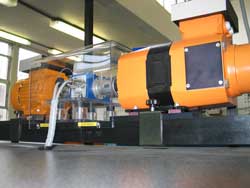
Posted to News on 31st Mar 2012, 17:21
Benefits of non-contact torque sensors for automotive industry
Sensor Technology explains the benefits offered by its TorqSense non-contact torque sensors for applications in the automotive industry.

Automotive manufacturers are under pressure to reduce vehicle emissions over the coming years. Work being undertaken in universities and research institutes is feeding into manufacturers' own R&D departments and out onto the world's roads at a high rate. To develop new generations of high-performance, low-emission power plants, new high-capability test beds have been developed to simultaneously monitor multiple parameters.
Sensor Technology's Tony Ingham explains: "An engine's torque is its fundamental characteristic and previous methods of measuring it are not good enough for today's demands. So we at Sensor Technology have developed TorqSense, a non-contact digital technology that can be set up in minutes and feed straight into TorqView software to produce data customised to each job. This allows the automotive engineers to concentrate on their development work rather than having to worry about the mechanical details of running tests.
"There are some really original thinkers working on engine design these days. They need like-for-like comparisons of the performance of petrol engines, diesel engines, LPG engines, electric motors, generators and regen units. Quite simply, TorqSense is their favourite way to do this."
Typically a modern test bed needs to be able to monitor all rotating shafts within various hybrid configurations of IC (internal combustion) engine and electric machine in moments. Traditional belt measurements and strain gauges are difficult to set up and use, whereas TorqSense is a direct in-line sensor that is said to give plug-and-play levels of ease and efficiency. TorqSense uses Surface Acoustic Wave sensors - see this article Surface Acoustic Wave technology - how it works.
Ingham states: "Motor testing is completely straightforward with TorqSense. Its digital signals and non-contact operation, easy set-up and automatic analysis means test regimes can be executed with the utmost efficiency."
Application examples
Lotus Engineering has always been at the forefront of automotive developments and has worked with Elektro Magnetix (EMX) of Brighton to develop a new hybrid power plant. Mapping the full performance range was an essential part of the project, but with a tight development timetable, testing had to be simple and effective.
Torque profiling can be a lengthy process because of the need to constantly refit and reset slip rings. Discovering TorqSense was a real boon for the project; EMX could set it up quickly, reset it at will, and half the analytical workload could be completed automatically.
Powertrain Technologies Ltd has designed an intelligent engine lubrication system. This incorporates a bank of computers to control oil supply to different parts of the engine. The system can be used on all sorts of engines: big or small; diesel or petrol; high-revving or low-speed. But each engine needs to be mapped in considerably detail over its entire performance range and in all climatic conditions. This amount of testing is very time-consuming, so an efficient test bed design was essential.
Fortunately Powertrain has been able to benefit from the expertise available at Sensor Technology. Suggestions for simple in-line test bed geometries and plug-and-play TorqSense technology have made a major contribution to time-to-market objectives.
TorqSense is also helping to reduce driver fatigue by improving power steering technologies. It forms the basis of a highly automated test cell at a Tier 1 supplier and checks nearly 200 systems an hour. A robot loads electrohydraulic motors into the test cell and, after testing, transfers them to either an exit conveyor or, in the event of a failure, to a secure holding area. However, it was realised that with the rapid throughput, losses could build up between the dynamometer and hysteresis brake of the cell and the motor under test. Sensor Technology was approached to see if it could suggest a solution to this problem.
Ingham again: "The robot's access requirements dictated that more space than normal was needed between the dynamometer and brake, leading to a relatively long connecting shaft and coupling. This was where the losses were going to accrue, so we suggested the elegantly simple solution of fitting a TorqSense in there to regularly and automatically check the torque inherent in the system.
"We set up the software to compensate the data output for the measured amount of 'offset'. This means a test sequence can be carried out quickly and efficiently. We also separately highlight the offset measurement so that the test engineers can make adjustment before things go out of tolerance."
Use the form on this page to request a callback or more information about Sensor Technology's TorqSense non-contact torque sensors for automotive applications or follow the link to the company's website.
Apollo Park, Ironstone Lane
Wroxton
OX15 6AY
UNITED KINGDOM
+44 (0)1869 238400






























